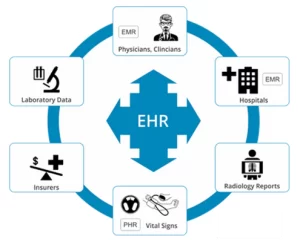What is EHR
The electronic health record includes all information contained in a traditional health record including a patient’s health profile, behavioral and environmental information. As well as content the EHR also includes the dimension of time, which allows for the inclusion of information across multiple episodes and providers, which will ultimately evolve into a lifetime record (World Health Organization and Regional Office for the Western Pacific 2006).

EHRs and the ability to exchange health information electronically can help you provide higher quality and safer care for patients while creating tangible enhancements for your organization. EHRs help providers better manage care for patients and provide better health care, providing accurate, up-to-date, and complete information about patients at the point of care.
- Securely sharing electronic information with patients and other clinicians Enhancing privacy and security of patient data.
- Reducing costs through decreased paperwork, improved safety, reduced duplication of testing, and improved health.
- EHR refers to a real time, unique longitudinal health record of a single individual containing his or her entire personal health information including medical details like history, medical examination, diagnosis, laboratory results, allergies, details of immunization, treatment etc.
Smart EHR
The EHR needs to create a holistic view of the patient’s health and reconstruct the patient’s medical history. This type of EHR, called the Smart EHR, could boost patient care by proposing better solutions. The Smart EHR would base these solutions on prior care led by providers.
A Smart EHR is an EHR system on a regional or national scale that utilizes a Virtual Health Record (VHR) that gives providers patient health information that offers solutions and diagnoses on an individual’s health.
The main three tasks of smart EHR are
- Foremost, the EHR should be able to manage and document all of an individual’s health events in the EHR by integrating all health-related information and associating it with a patient’s life event.
- Second, it should be able to notify the patient of potential real-world events that could negatively impact the patient’s health.
- Third, a Smart EHR must be able to create virtual environments by digitalizing real world health-related activities into the EHR according to a patient’s health-related needs.
- And finally, a Smart EHR would ideally integrate real-world events, such as a pandemic, and activities in the EHR, and also reverse this process by integrating health resources and solutions in the virtual world into the real world.
Benefits of EHR
- Security to Patient Data.
- Reduction in Medical Errors.
- Timely Accurate Health Data.
- Quick and Easy Access to Patient’s Information.
- E-Prescribing
- Electronic Documentation Management
- Reporting and Optimizing Administrative Workflow
- Better Quality of Patient Care.
- Improves coordination of care
- Cost savings through efficiencies and improved patient management.
- Enhancing privacy and security of patient data.
- Managing medications through an EHR improves patient outcomes over time.
- Custom Solutions to predict the risks based on patient data
- Assists at the point of care…and more
Source:EHR Solution: Organizing Medical Data in a Smart Way | softengi.com



